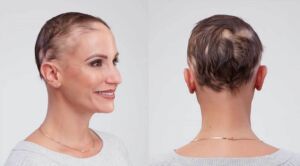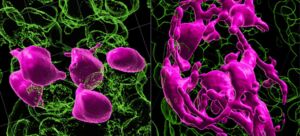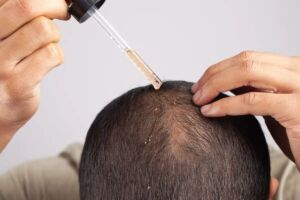Alopecia is a term used to describe hair loss, either on specific areas of the scalp or all over the body. It is a condition that affects both men and women and can have various causes, including genetic, hormonal, environmental and health factors. There are different types of alopecia, the most common being androgenetic alopecia (male and female pattern baldness), telogen effluvium (temporary and intense hair loss due to changes in the hair growth cycle) and alopecia areata (hair loss due to an autoimmune response).
Androgenetic alopecia is the most common type of long-term hair loss in both men and women. It is a genetic and hormonal condition in which the hair follicles are sensitive to the effects of sex hormones, especially dihydrotestosterone (DHT). In this type of alopecia, the hair follicles gradually produce thinner and shorter hair, until eventually they stop producing new hair, resulting in a progressive reduction in hair density and the appearance of bald or thinning areas.
The main signs that patients with androgenetic alopecia report are gradual hair loss, mainly in the frontal region, on the top of the head or at the entrances. In men, the formation of what is known as a “crown” or “entrance” may also occur. In women, hair loss is generally more diffuse, with no specific pattern.
There are various treatments available for androgenetic alopecia, including topical, oral and injectable medications, which can help slow down hair loss and stimulate new hair growth. In addition, hair transplantation is an effective option for restoring bald areas or areas with low hair density.
The understanding of alopecia has advanced over the years thanks to ongoing scientific research. New studies and discoveries are constantly contributing to knowledge about the mechanisms underlying alopecia, as well as to the development of more effective treatment options. Currently, several studies are being conducted to explore drug-based therapies, gene therapy and Regenerative Medicine therapy with growth factors and exosomes. These promising approaches aim to offer innovative and more effective alternatives to treat hair loss by directly targeting the mechanisms underlying androgenetic alopecia.
Alopecia can have a significant impact on the self-esteem and emotional well-being of those affected. It is therefore important to seek reliable and up-to-date information on this subject, which has been the subject of major scientific advances in recent years.”
5 estrelas ! A CAPILART tem os serviços excepcionais. Super atenciosos, muito dedicados, toda a equipa médica muito profissional e sempre disponível ,um bem haja á Dr.Tania por todo o carinho e atenção, das melhores profissionais que tive muito gosto em conhecer. Fiz o meu implante com eles e correu tudo super bem, não senti dor em nenhum momento, não fiquei inchado, a recuperação foi muito boa, todas as indicações dadas pela doutora segui á risca e correu tudo super bem. Recomendo estes serviços, vão ser melhor atendidos nesta clinica do que em qualquer outra. Muito obrigado por todo o profissionalismo !

FDA Approves LITFULO™ (Ritlecitinib) for Adults and Adolescents with Severe Alopecia Areata
Today, the U.S. Food and Drug Administration (FDA) approved LITFULO™ for severe alopecia areata, marking the second FDA-approved treatment for this disease and the first approved for children 12 years and older

Study Links ‘Stuck’ Stem Cells with Hair to Turning Gray
A new study led by researchers at NYU Grossman School of Medicine has revealed that certain stem cells possess the unique ability to move between growth compartments in hair follicles, but get “stuck” as people

An ancient medicine helps fight baldness, experts say
Dermatologists who specialize in hair loss report that a key component of a topical treatment works even better when taken in small doses orally.
Do you have any questions?
Renew your self-esteem with innovative techniques, offering natural and lasting results